Would You Eat These Futuristic Foods?
Kira Peikoff was the editor-in-chief of Leaps.org from 2017 to 2021. As a journalist, her work has appeared in The New York Times, Newsweek, Nautilus, Popular Mechanics, The New York Academy of Sciences, and other outlets. She is also the author of four suspense novels that explore controversial issues arising from scientific innovation: Living Proof, No Time to Die, Die Again Tomorrow, and Mother Knows Best. Peikoff holds a B.A. in Journalism from New York University and an M.S. in Bioethics from Columbia University. She lives in New Jersey with her husband and two young sons. Follow her on Twitter @KiraPeikoff.
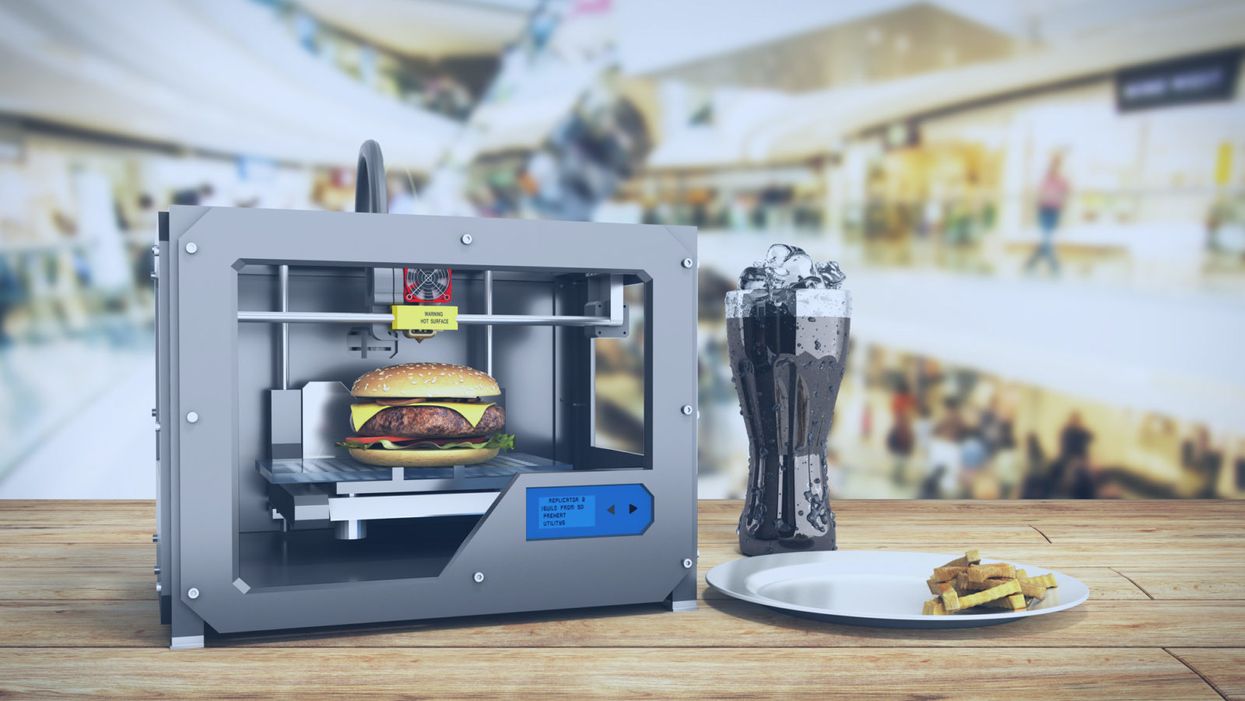
A rendering of a 3D-printed burger.
Imagine it's 2050. You wake up and make breakfast: fluffy scrambled eggs that didn't come from a chicken, but that taste identical to the ones you remember eating as a kid. You would never know that the egg protein on your plate, ovalbumin, was developed in an industrial bioreactor using fungi.
"We have this freedom to operate, freedom to engineer way beyond what we have now with livestock or plants."
For lunch, you head to your kitchen's 3D printer and pop in a cartridge, select your preferred texture and flavor, then stand back while your meal is chemically assembled. Afterward, for dessert, you snack on some chocolate that tastes more delicious than the truffles of the past. That's because these cocoa beans were gene-edited to improve their flavor.
2050 is not a random year –it's when the United Nations estimates that the world population will have ballooned to nearly 10 billion people. That's a staggering number of mouths to feed. So, scientists are already working on ways to make new food products that are unlike anything we consume today, but that could offer new, potentially improved nutritional choices and sustainable options for the masses. To whet your appetite, here are three futuristic types of food that are currently in development around the world:
1) Cellular Agriculture
Researchers at VTT Technical Research Centre of Finland, a leading R&D organization in Europe, are on the cutting-edge of developing a whole new ecosystem of food with novel ingredients and novel functionality.
In the high-tech world of cellular agriculture, single-cell organisms can be used in contained environments to produce food ingredients that are identical to traditionally sourced ingredients. For example, whey protein can be developed inside a bioreactor that is functionally the same as the kind in cow's milk.
Ditto for eggs without a chicken – so the world will finally know which came first.
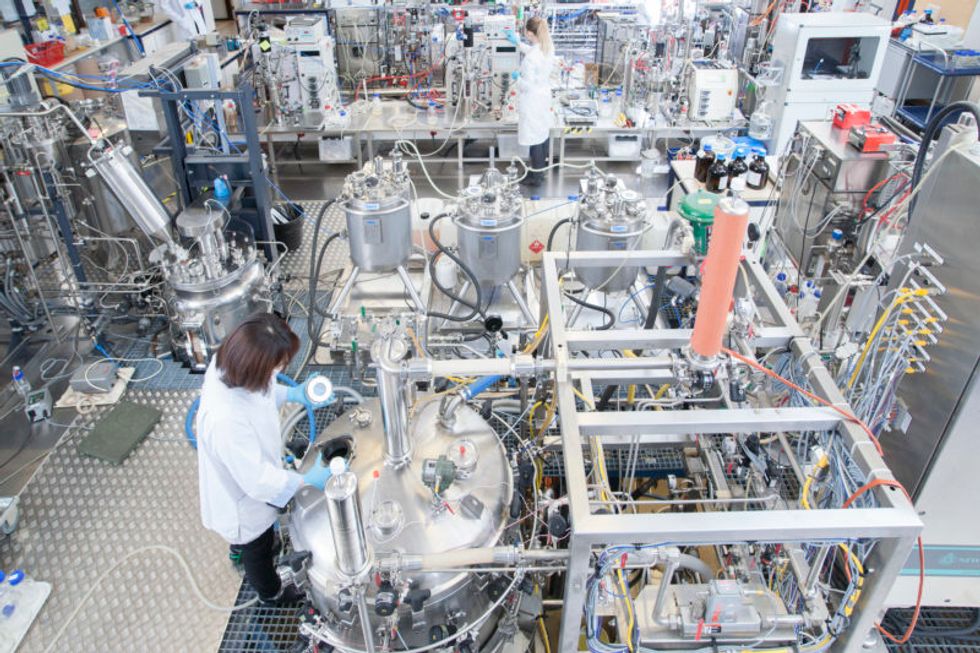
The steel tank bioreactors in VTT´s piloting facility are used to grow larger amounts of plant cells or to brew dairy and egg proteins with microbes.
(VTT)
"We take the gene from a chicken genome, and place that in a microbe, and then the microbe can, with those instructions, make exactly the same protein," explains Lauri Reuter, a Senior Specialist at VTT who holds a doctorate in biotechnology. "It will swim in this bioreactor and kick out the protein, and we get this liquid that can be purified. Then you would cook or bake with it, and the food you would eat tastes and looks like food you would eat right now."
But why settle for what chickens can do? With this technology, it's possible, for example, to modify the ovalbumin protein to decrease its allergenicity.
"This is the power of what we can do with modern tools of genetic engineering," says Christopher Landowski,a Research Team Leader of the Protein Production Team. And the innovative potential doesn't stop there.
"We have this freedom to operate, freedom to engineer way beyond what we have now with livestock or plants," Reuter says. Future foods sourced from cells could include meat analogues, sugar substitutes, dairy substitutes, nutritious veggies that don't taste bitter, personalized nutrition – ingredients designed for individual needs; the list goes on. It could even be used one day to produce food on Mars.
The researchers emphasize the advantages of this method: their living cell factories are efficient – no care of complex animals is required; they can scale up or down in reaction to demand; their environments are contained and don't require antibiotics; and they provide an alternative to using animals.
But the researchers also readily admit that the biggest obstacle is consumer acceptance, which is why they seek to engage with people along the way to alleviate any concerns and to educate them about the technology. Novel foods of this sort have already been eaten in research settings, but it may take another three to five years before the egg and milk proteins hit the market, probably first in the United States before Europe.
Eventually, the researchers anticipate widespread adoption.
Emilia Nordlund, who directs the Food Solutions team, predicts, "Cellular agriculture will revolutionize the food industry as dramatically as the Internet revolutionized many other industries."
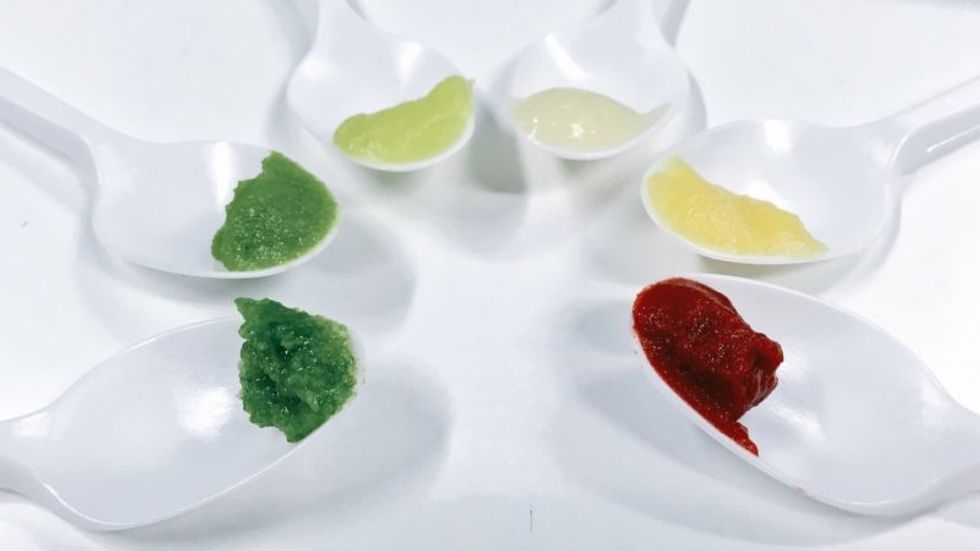
Jams made of culture cells of various plants: strawberry, scurvy grass, arctic bramble, tobacco, cloudberry and lingonberry.
(VTT/Lauri Reuter)
2) 3D-printed foods
In South Korea, researchers are developing 3D-printed foods to help solve a problem caused by aging. Elderly people often rely on soft foods which are easier to chew, but aren't always healthy, like Jello and pudding.
With 3D printing, foods of softer textures can be created with the same nutritional value as firmer food, via a processing method that breaks down the food into tiny nutrients by grinding it at a very low temperature with liquid nitrogen.
"The goal is that someone at home can print out food with whatever flavor and texture they want."
The micro-sized food materials are then reconstructed in layers to form what looks like a Lego block. "The cartridges are all textures, some soft and some stiff," explains Jin-Kyu Rhee, associate professor at Ewha Womans University, whose project has been funded for the last three years by the South Korean government. "We are developing a library of food textures, so that people can combine them to simulate a real type of food."
Users could then add powdered versions of various ingredients to create customized food. Flavor, of course, is of prime importance too, so the cartridges have flavors like barbecue to help simulate the experience of eating "real" food.
"The goal is that someone at home can print out food with whatever flavor and texture they want," Rhee says. "They can order their own cartridge and digital recipes to generate their own food, ready to cook with a microwave oven." It could also be used for space travel.
Rhee expects the prototype of the printer to be completed by the end of this year and will then seek out a commercial partner. If all goes well, you might be able to set up your 3D printer next to your coffee pot by 2025.
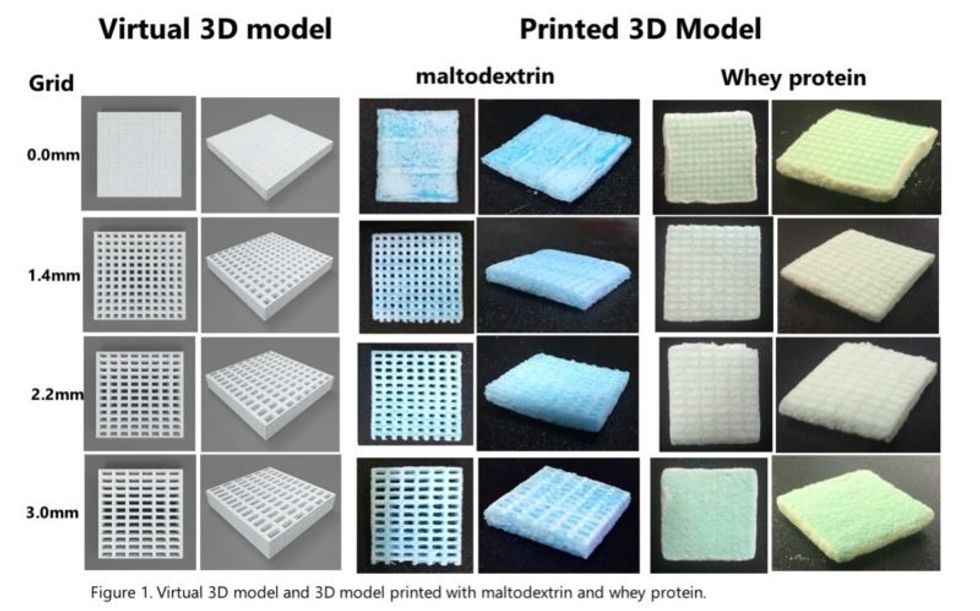
3) CRISPR-edited foods
You may not know that the cocoa plant is having a tough time out there in nature. It's plagued by fungal disease; on farms, about 30 to 40 percent of the potential cocoa beans are lost every year. For all the chocolate lovers of the world, this means less to go around.
Conventional plant breeding is very slow for trees, so researchers like Mark Guiltinan at Penn State University are devising ways to increase the plants' chances for survival – without moving any genes between species, as in genetically modified organisms (GMOs).
"Because society hasn't really embraced [GMOs] very much, we're trying to develop ways that don't use transgenic plants and speed up breeding," Guiltinan says.
He and his colleagues are using CRISPR-cas9, the precise method of editing DNA, to imbue cocoa plants with immunity to fungal disease.
How does it work? Similar to humans, the plants have an immune system. Part of it functions like brakes, repressing the whole system so it's only working when it needs to.
"Like when you get a fever, your immune system is working full blast, but your body shuts it down when it doesn't need it," he explains. "Plants do exactly the same thing. One idea is if we can reduce or eliminate that brake on the immune system, we could make plants that have a very high immunity."
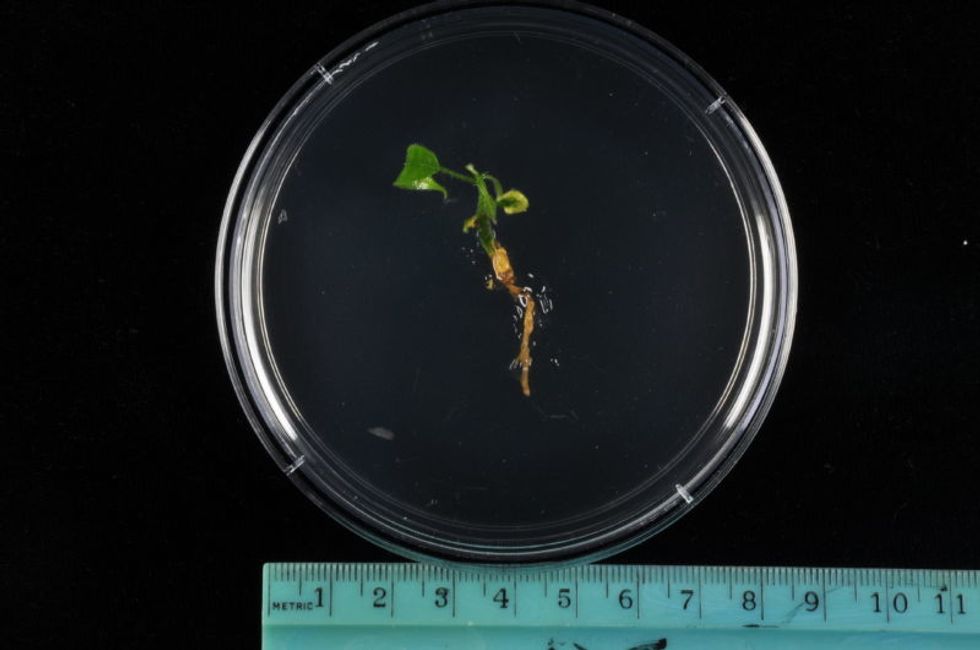
A CRISPR-edited npr3 mutant cacao plantlet, not too much to see yet, but soon it will become a happy plant in the greenhouse.
(Photo credit: Mark Guiltinan)
The CRISPR-cas9 system allows "a really amazing little protein" to go into the cocoa plant cell, find a specific gene, and shut it off to put the whole immune system into overdrive. This confers the necessary immunity, and though the plant burns through a lot of energy, as if it has a fever all the time, this method would allow for more plants to fend off the fungal attacks every year. Which means more chocolate. It could also greatly reduce the need for pesticides.
"Replacing chemicals with genetics is one part of our goal," Guiltinan says. "And it's totally safe." Another goal of his project is to improve the cocoa beans' quality and flavor profile through gene editing.
Yum. Is your mouth watering yet?
Kira Peikoff was the editor-in-chief of Leaps.org from 2017 to 2021. As a journalist, her work has appeared in The New York Times, Newsweek, Nautilus, Popular Mechanics, The New York Academy of Sciences, and other outlets. She is also the author of four suspense novels that explore controversial issues arising from scientific innovation: Living Proof, No Time to Die, Die Again Tomorrow, and Mother Knows Best. Peikoff holds a B.A. in Journalism from New York University and an M.S. in Bioethics from Columbia University. She lives in New Jersey with her husband and two young sons. Follow her on Twitter @KiraPeikoff.
Niklas Anzinger is the founder of Infinita VC based in the charter city of Prospera in Honduras. Infinita focuses on a new trend of charter cities and other forms of alternative jurisdictions. Healso hosts a podcast about how to accelerate the future by unblocking “stranded technologies”.This spring he was a part of the network city experiment Zuzalu spearheaded by Ethereum founder Vitalik Buterin where a few hundred invited guests from the spheres of longevity, biotechnology, crypto, artificial intelligence and investment came together to form a two-monthlong community. It has been described as the world’s first pop-up city. Every morning Vitalians would descend on a long breakfast—the menu had been carefully designed by famed radical longevity self-experimenter Bryan Johnson—and there is where I first met Anzinger who told me about Prospera. Intrigued to say the least, I caught up with him later the same week and the following is a record of our conversation.
Q. We are sitting here in the so-called pop-up network state Zuzalu temporarily realized in the village of Lusticia Bay by the beautiful Mediterranean Sea. To me this is an entirely new concept: What is a network state?
A. A network state is a highly aligned online community that has a level of in-person civility; it crowd-funds territory, and it eventually seeks diplomatic recognition. In a way it's about starting a new country. The term was coined by the crypto influencer and former CTO of Coinbase Balaji Srinivasan in a book by the same title last year [2022]. What many people don't know is that it is a more recent addition or innovation in a space called competitive governance. The idea is that you have multiple jurisdictions competing to provide you services as a customer. When you have competition among governments or government service providers, these entities are forced to provide you with a better service instead of the often worse service at higher prices or higher taxes that we're currently getting. The idea went from seasteading, which was hardly feasible because of costs, to charter cities getting public/private partnerships with existing governments and a level of legal autonomy, to special economic zones, to now network states.
Q. How do network states compare to charter cities and similar jurisdictions?
A. Charter cities and special economic zones were legal forks from other existing states. Dubai, Shenzhen in China, to some degree Hong Kong, to some degree Singapore are some examples. There's a host of other charter cities, one of which I'm based in myself, which is Prospera located in Honduras on the island Roatán. Charter cities provide the full stack of governance; they provide new laws and regulations, business registration, tax codes and governance services, Estonia style: you log on to the government platform and you get services as a citizen.
When conceptualizing network states, Balagi Srinivasan turns the idea of a charter city a bit on its head: he doesn't want to start with this full stack because it's still very hard to get these kinds of partnerships with government. It's very expensive and requires lots of experience and lots of social capital. He is saying that network states could instead start as an online community. They could have a level of alignment where they trade with each other; they have their own economy; they meet in person in regular gatherings like we're doing here in Zuzulu for two months, and then they negotiate with existing governments or host cities to get a certain degree of legal autonomy that is centered around a moral innovation. So, his idea is: don't focus on building a completely new country or city; focus on a moral innovation.
Q. What would be an example of such a moral innovation?
A. An example would be longevity—life is good; death is bad—let's see what we can do to foster progress around that moral innovation and see how we can get legal forks from the existing system that allow us to accelerate progress in that area. There is an increasing realization in the science that there are hallmarks of aging and that aging is a cause of other diseases like cancer, ALS or Alzheimer's. But aging is not recognized as a disease by the FDA in the United States and in most countries around the world, so it's very hard to get scientific funding for biotechnology that would attack the hallmarks of aging and allow us potentially to reverse aging and extend life. This is a significant shortcoming of existing government systems that groups such as the ones that have come together here in Montenegro are now seeking alternatives too. Charter cities and now network states are such alternatives.
Q. Would it not be better to work within the current systems, and try to improve them, rather than abandon them for new experimental jurisdictions?
A. There are numerous failures of public policies. These failures are hard, if not impossible, to reverse, because as soon as you have these policies, you have entrenched interests who benefit from the regulations. The only way to disrupt incumbent industries is with start-ups, but the way the system is set up makes it excessively hard for such start-ups to become big companies. In fact, larger companies are weaponizing the legal system against small companies, because they can afford the lawyers and the fixed cost of compliance.
I don't believe that our institutions in many developed countries are beyond hope. I just think it's easier to change them if you could point at successful examples. ‘Hey, this country or this zone is already doing it very successfully’; if they can extend people’s lifespan by 10 years, if they can reduce maternal mortality, and if they have a massive medical tourism where people come back healthier, then that is just very embarrassing for the FDA.
Q. Perhaps a comparison here would be the relationship between Hong Kong and China?
A. Correct, so having Hong Kong right in front of your door … ‘Hey, this capitalism thing seems to work, why don't we try it here?’ It was due to the very bold leadership by Deng Xiaoping that they experimented with it in the development zone of Shenzhen. It worked really well and then they expanded with more special economic zones that also worked.

Próspera is a private city and special economic zone on the island of Roatán in the Central American state of Honduras.
Q. Tell us about Prospera, the charter city in Honduras, that you are intimately connected with.
A. Honduras is a very poor country. It has a lot of crime, never had a single VC investment, and has a GDP per capita of 2,000 per year. Honduras has suffered tremendously. The goal of these special economic zones is to bring in economic development. That's their sole purpose. It's a homegrown innovation from Honduras that started in 2009 with a very forward-thinking statesman, Octavio Sanchez, who was the chief of staff to the president of Honduras, and then president. He had his own ideas about making Honduras a more decentralized system, where more of the power lies in the municipalities.
Inspired by the ideas of Nobel laureate economist Paul Romer, who gave a famous Ted Talk in 2009 about charter cities, Sanchez initiated a process that lasted for years and eventually led to the creation of a special economic zone legal regime that’s anchored in the Hunduran constitution that provides the highest legal autonomy in the world to these zones. There are today three special economic zones approved by the Honduran government: Prospera, Ciudad Morazan and Orchidea.
Q. How did you become interested and then involved in Prospera?
A. I read about it first in an article by Scott Alexander, a famous rationalist blogger, who wrote a very long article about Prospera, and I thought, this is amazing! Then I came to Prospera and I found it to be one of the most if not the most exciting project in the world going on right now and that it also opened my heart to the country and its people. Most of my friends there are Honduran, they have been working on this for 10 or more years. They want to remake Honduras and put it on the map as the place in the world where this legal and governance innovation started.
Q. To what extent is Prospera autonomous relative to the Honduran government?
A. What's interesting about the Honduran model is that it's anchored within the Honduran constitution, and it has a very clear framework for what's possible and what's not possible, and what's possible ensures the highest degree of legal autonomy anywhere seen in the world. Prospera has really pushed the model furthest in creating a common law-based polycentric legal system. The idea is that you don't have a legislature, instead you have common law and it's based on the best practice common law principles that a legal scholar named Tom W. Bell created.
One of the core ideas is that as a business you're not obligated to follow one regulatory monopoly like the FDA. You have regulatory flexibility so you can choose what you're regulated under. So, you can say: ‘if I do a medical clinic, I do it under Norwegian law here’. And you even have the possibility to amend it a bit. You're still required to have liability insurance, and have to agree to binding arbitration in case there's a legal dispute. And your insurance has to approve you. So, under that model the insurance becomes the regulator and they regulate through prices. The limiting factor is criminal law; Honduran criminal law fully applies. So does immigration law. And we pay taxes.
Q. Is there also an idea of creating a kind of healthy living there, and encourage medical tourism?
A. Yes, we specifically look for legal advantages in autonomy around creating new drugs, doing clinical trials, doing self-medication and experimentation. There is a stem cell clinic here and they're doing clinical trials. The island of Roatán is very easily accessible for American tourists. It's a beautiful island, and it's for regulatory reasons hard to do stem cell therapies in the United States, so they're flying in patients from the United States. Most of them are very savvy and often have PhDs in biotech and are able to assess the risk for themselves of taking drugs and doing clinical trials. We're also going to get a wellness center, and there have been ideas around establishing a peptide clinic and a compound pharmacy and things like that. We are developing a healthcare ecosystem.
Q. This kind of experimental tourism raises some ethical issues. What happens if patients are harmed? And what are the moral implications for society of these new treatments?
A. As a moral principle we believe in medical freedom: people have rights over their bodies, even at the (informed) risk of harm to themselves if no unconsenting third-parties are harmed; this is a fundamental right currently not protected effectively.
What we do differently is not changing ethical norms around safety and efficacy, we’re just changing the institutional setup. Instead of one centralized bureaucracy, like the FDA, we have regulatory pluralism that allows different providers of safety and efficacy to compete under market rules. Like under any legal system, common law in Prospera punishes malpractice, fraud, murder etc. This system will still produce safe and effective drugs, and it will still work with common sense legal notions like informed consent and liability for harm. There are regulations for medical practice, there is liability insurance and things like that. It will just do so more efficiently than the current way of doing things (unless it won’t, in which case it will change and evolve – or fail).
A direct moral benefit ´to what we do is that we increase accessibility. Typical gene therapies on the market cost $1 million dollars in the US. The gene therapy developed in Prospera costs $25,000. As to concern about whether such treatments are problematic, we do not share this perspective. We are for advancing science responsibly and we believe that both individuals and society stand to gain from improving the resiliency of the human body through advanced biotechnology.
Q. How does Prospera relate to the local Honduran population?
A. I think it's very important that our projects deliver local benefits and that they're well anchored in local communities. Because when you go to a new place, you're seen as a foreigner, and you're seen as potentially a danger or a threat. The most important thing for Prospera and Ciudad Morazan is to show we're creating jobs; we're creating employment; we're improving people's lives on the ground. Prospera is directly and indirectly employing 1,100 people. More than 2/3 of the people who are working for Prospera are Honduran. It has a lot of local service workers from the island, and it has educated Hondurans from the mainland for whom it's an alternative to going to the United States.
Q. What makes a good Prosperian citizen?
A. People in Prospera are very entrepreneurial. They're opening companies on a small scale. For example, Vehinia, who is the cook in the kitchen at Prospera, she's from the neighboring village and she started an NGO that is now funding a school where children from the local village can go to instead of a school that's 45 minutes away. There's very much a spirit of ‘let's exchange and trade with each other’. Some people might see that as a bit too commercial, but that's something about the culture that people accept and that people see as a good thing.
Q. Five years from now, if everything goes well, what do we see in Prospera?
A. I think Prospera will have at least 10,000 residents and I think Honduras hopefully will have more zones. There could be zones with a thriving industrial sector and sort of a labor-intensive economy and some that are very strong in pharmaceuticals, there could also be other zones for synthetic biology, and other zones focused on agriculture. The zones of Prospera, Ciudad Morazan and Orchidea are already showing the results we want to see, the results that we will eventually be measured by, and I'm tremendously excited about Honduras.
How to Measure Your Stress, with Dr. Rosalind Picard
Today’s podcast guest is Rosalind Picard, a researcher, inventor named on over 100 patents, entrepreneur, author, professor and engineer. When it comes to the science related to endowing computer software with emotional intelligence, she wrote the book. It’s published by MIT Press and called Affective Computing.
Dr. Picard is founder and director of the MIT Media Lab’s Affective Computing Research Group. Her research and engineering contributions have been recognized internationally. For example, she received the 2022 International Lombardy Prize for Computer Science Research, considered by many to be the Nobel prize in computer science.
Through her research and companies, Dr. Picard has developed wearable sensors, algorithms and systems for sensing, recognizing and responding to information about human emotion. Her products are focused on using fitness trackers to advance clinical quality treatments for a range of conditions.
Meanwhile, in just the past few years, numerous fitness tracking companies have released products with their own stress sensors and systems. You may have heard about Fitbit’s Stress Management Score, or Whoop’s Stress Monitor – these features and apps measure things like your heart rhythm and a certain type of invisible sweat to identify stress. They’re designed to raise awareness about forms of stress such as anxieties and anger, and suggest strategies like meditation to relax in real time when stress occurs.
But how well do these off-the-shelf gadgets work? There’s no one more knowledgeable and experienced than Rosalind Picard to explain the science behind these stress features, what they do exactly, how they might be able to help us, and their current shortcomings.
Dr. Picard is a member of the National Academy of Engineering and a Fellow of the National Academy of Inventors, and a popular speaker who’s given over a hundred invited keynote talks and a TED talk with over 2 million views. She holds a Bachelors in Electrical Engineering from Georgia Tech, and Masters and Doctorate degrees in Electrical Engineering and Computer Science from MIT. She lives in Newton, Massachusetts with her husband, where they’ve raised three sons.
In our conversation, we discuss stress scores on fitness trackers to improve well-being. She describes the difference between commercial products that might help people become more mindful of their health and products that are FDA approved and really capable of advancing the science. We also talk about several fascinating findings and concepts discovered in Dr. Picard’s lab including the multiple arousal theory, a phenomenon you’ll want to hear about. And we explore the complexity of stress, one reason it’s so tough to measure. For example, many forms of stress are actually good for us. Can fitness trackers tell the difference between stress that’s healthy and unhealthy?
Show links:
- Dr. Picard’s book, Affective Computing
- Dr. Picard’s bio
- Dr. Picard on Twitter
- Dr. Picard’s company, Empatica - https://www.empatica.com/ - The FDA-cleared Empatica Health Monitoring Platform provides accurate, continuous health insights for researchers and clinicians, collected in the real world
- Empatica Twitter
- Dr. Picard and her team have published hundreds of peer-reviewed articles across AI, Machine Learning, Affective Computing, Digital Health, and Human-computer interaction.
- Dr. Picard’s TED talk

Rosalind Picard

